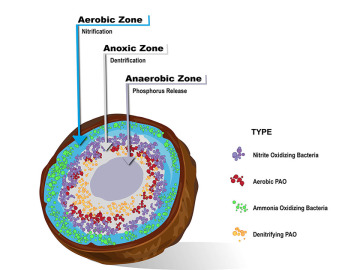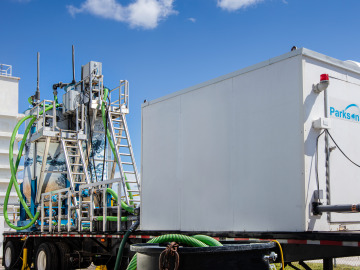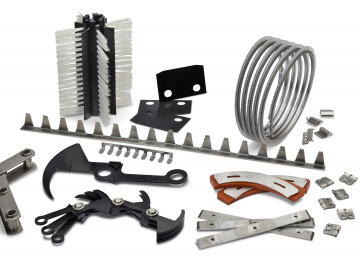Parkson’s Complete Enhanced Nutrient Removal (ENR) System Outperforms in a Chesapeake Bay Wastewater Treatment Plant
FORT LAUDERDALE, FL – Parkson Corp. has successfully demonstrated a complete enhanced nutrient removal system, proving its ability to cut costs and meet strict wastewater treatment requirements.
The results from the 18-month trial of the new DynaSand® EcoWash™ filtration system combined with the Biolac® extended aeration activated sludge show that this system performs effectively and at approximately half the capital cost of competing designs.
The town of Laurel is located in Sussex County in southwest Delaware. Effluent from the treatment facility discharges into Broad Creek, which is a tributary of the Nanticoke River and then to the Chesapeake Bay. The Wastewater Treatment Plant (WWTP) at Laurel, DE, was required to upgrade its facultative lagoon system to an ENR capable system to meet the new regulations established for the Chesapeake Bay watershed. The specified ENR effluent limits are BOD5 < 5.0 mg/l, TSS < 5.0 mg/l, TN < 3.0 mg/l, and TP < 0.5 mg/l.
The Laurel plant was upgraded and started up in 2007 with a Biolac® activated sludge system which included the enhanced Wave Oxidation (WaveOx) control system and a DynaSand® ENR continuous backwash filtration system. Compared to other aeration systems, the Biolac® incorporates movable diffusers which allow for sufficient activation even when keeping aeration low. This system utilizes the built-in flexibility of the WaveOx design to manipulate DO levels to optimize nitrification and denitrification in the Biolac® system. The DynaSand® ENR filtration system is designed to polish the effluent from the Biolac® WaveOx to remove nitrate and phosphorous in one step, meeting the ENR effluent requirements.
Laurel WWTP is currently operating at approximately half the design load which challenges the performance of the biological processes in the plant. In spite of this significant factor, the effluent quality at the facility is better than the required ENR effluent limits.
“We worked closely with the operators to fine-tune the system to run as efficiently as possible,” said Farid Kade, Biolac® Product Manager. “The WaveOx control system really makes that possible, by offering greater flexibility to monitor and control the process better than we’ve ever had before.”
In 2010, Parkson developed the DynaSand® EcoWash™ system, which improves the DynaSand® filter by changing the continuous backwash into an intermittent backwash process. The intermittent backwash allows solids to accumulate in the sand bed, creating a thin layer (known as Schmutzdecke) that reduces the voids between the sand grains improving the solids capture rate of the filter. The addition of the EcoWash™ intermittent backwashing sand filtration system at Laurel WWTP enabled the plant to cut chemical usage in half and reduce energy consumption by around
90%. The results showed that the DynaSand® EcoWash™ filter consistently provided effluent nitrate (NO3-N) concentrations below detection limit of 0.2 mg/L even with instantaneous influent nitrate as high as 14 mg/l and 12 mg/l. At the same time, the EcoWash™ achieved a 90% reduction in reject water compared to continuous backwash operation, which dramatically reduces the reprocessing flow through the plant.
“The EcoWash™ design has performed very well and exceeded the expectations of everyone in the community,” said Marianna Novellino, Product Manager for Filtration and ENR Filtration at Parkson. “Operators and engineers like this technology because it doesn’t require extensive training to make the system perform at its best.”
Parkson and partners from Kershner Environmental Technologies presented their findings during an open house at the plant in late June, which drew more than 60 engineers and plant operators from the Chesapeake Bay area and beyond. Technologies like EcoWash™ are very attractive for operators seeking cost-effective ways to meet tighter limits over nitrogen and phosphorous levels in effluent water.
“This project really stands out because it is a clean, unobtrusive design that costs half the price of other ENR systems available now,” said Robert Kershner, President of Kershner Environmental Technologies. “When you add up the investment and the operating costs, the design offers huge savings over the entire life of the system.”
For existing users of Parkson’s DynaSand® and similar continuous backwashing filtration systems, the EcoWash™ technology is available as a conversion process that will generate a return on investment in less than three years. At the same time, the upgrade to the intermittent backwash operation significantly extends the lifetime of the airlift.
The event showcasing Parkson’s complete enhanced nutrient removal system at Laurel was organized with help from the Water and Waste Operators Association of Maryland, Delaware and District of Columbia.



